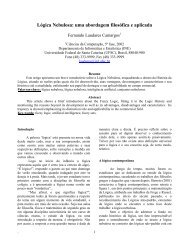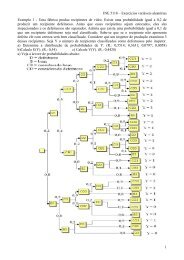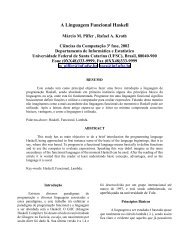Anais do IHC'2001 - Departamento de Informática e Estatística - UFSC
Anais do IHC'2001 - Departamento de Informática e Estatística - UFSC
Anais do IHC'2001 - Departamento de Informática e Estatística - UFSC
Create successful ePaper yourself
Turn your PDF publications into a flip-book with our unique Google optimized e-Paper software.
<strong>Anais</strong> <strong>do</strong> IHC’2001 - IV Workshop sobre Fatores Humanos em Sistemas Computacionais 63<br />
2. Un<strong>de</strong>rstanding Communication in the Software Design Process<br />
In a software <strong>de</strong>velopment organisation, all the work groups need to know what is going<br />
on, and the impact that the interaction and communication processes taking place among<br />
all these people has in the product.<br />
“There are the rest of the engineers on the project who have to believe in the system<br />
enough to co<strong>de</strong> it. There are the project teams working on systems that have to interface<br />
to yours. There is your manager, his manager (…) There is the marketing and the<br />
product-planning <strong>de</strong>partment who tend to be sceptical of i<strong>de</strong>as coming out of<br />
engineering. There is the sales force of a commercial product, which needs to<br />
un<strong>de</strong>rstand what makes the new product worth selling. And there are the customers,<br />
who need to be convinced that the new system will improve their lives” [3, p. 199].<br />
Beyer and Holtzblatt [3] argue that it is not feasible to inclu<strong>de</strong> all the people who care<br />
about the result in the same <strong>de</strong>sign team. On the other hand, they maintain that a crossfunctional<br />
team, <strong>de</strong>spite being important to bring the perspectives of the different groups to<br />
<strong>de</strong>sign, <strong>do</strong>es not guarantee communication back to the groups. The authors propose<br />
multiple strategies and techniques to enable communication among the groups, through the<br />
Contextual Design.<br />
Contextual Design presupposes that any system embodies a way of working. As so, it is a<br />
method that <strong>de</strong>fine a series of actions that lead a team to agreement on what their<br />
customers need and how to <strong>de</strong>sign a system for them. The main contribution of this<br />
approach is a series of techniques that forces people to interact with data, to share a space<br />
for analysing customer data, to engage with work mo<strong>de</strong>ls, and mainly to tailor conversation<br />
to the concerns and work style of each involved group.<br />
Semiotic approaches perceive the software interface as a communication act between<br />
<strong>de</strong>signers and users, using the computer as medium [16], [6], [2]. The <strong>de</strong>signers establish<br />
the limits of this communication and create a set of signs that users can activate [2], which<br />
means that <strong>de</strong>signers are the sen<strong>de</strong>rs of this communication mo<strong>de</strong>l. Semiotic Engineering<br />
[6] consi<strong>de</strong>rs the message itself a meta-communication artefact, since the interface<br />
exchanges messages with users.<br />
The focus of this work is the communication involved in the <strong>de</strong>sign and <strong>de</strong>velopment of<br />
computational artefacts. One aspect of this communication is the dialogue between<br />
<strong>de</strong>signers and users. As Adler and Winograd point out [1], this kind of communication is<br />
embed<strong>de</strong>d in every kind of artefact. Through their structure and appearance, <strong>de</strong>signed<br />
objects express more or less effectively what they are, how they are used, and how they are<br />
integrated with the embed<strong>de</strong>d context. According to semiotic approaches in HCI, this<br />
structure and appearance - i.e., the interface- can be un<strong>de</strong>rstood as a message sent from<br />
<strong>de</strong>signers to users using the computer as channel.<br />
We argue that in or<strong>de</strong>r to <strong>de</strong>sign this message, all the involved groups need to <strong>de</strong>velop a<br />
common un<strong>de</strong>rstanding about what is going to be <strong>do</strong>ne. On the one hand, there are the<br />
users’ needs and expectations; on the other hand, there are contextual, technological,<br />
budget and schedule constraints that limit the possible <strong>de</strong>sign solutions. Not only <strong>de</strong>signers<br />
and users, but also the remaining agents must engage in a process of negotiation, which we<br />
un<strong>de</strong>rstand as a conversational process. In this conversation, many communication acts<br />
occur, many messages are exchanged using different channels.

















